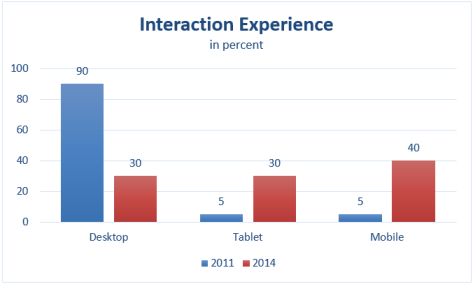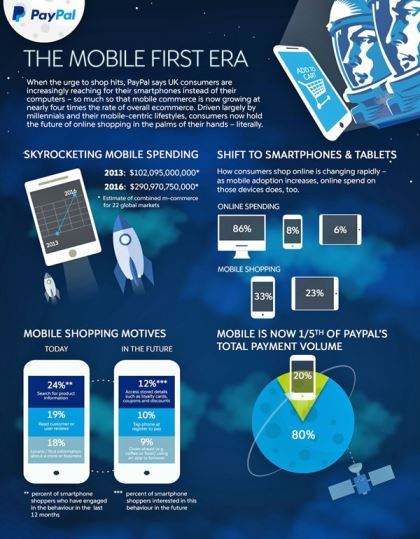Rumor has it that more smartphones are present in the world today than toothbrushes – a horrifying thought – and an estimated 83 percent of internet usage will be through mobile devices, according to Deloitte.
It’s also estimated that a projected 65 percent of the global population will be using a mobile phone this year.
The introduction of wearables like Google Glass, and Apple Watch next month, as well as other wearable technology, further fuels mobile development and are supposed to affect other industries as Jeff Pike elaborated on in the potential of wearable technology in A&D in his post last August. Our position was initially described in an article in The Manufacturer in April last year.
It is no surprise, then, that mobile retailing is expected to continue to grow aggressively as it opens new opportunities for reaching consumers.
Gadget independence is a prerequisite these days as multi-retailing (bricks and mortar have gone eCom) is the reality and starting to be executed as omni (a consistent, seamless brand experience cross all channels interdependently at the choice of the end-consumer), and the mobile experience becomes even more important.
We want to use mobile as our wallet and as our instrument of understanding the status of our latest purchase – see the PayPal scheme illustrated here.
Whether that’s through a native experience or through the modern app really does not matter as long as the experience is a seamless one and the device is easy to use.
Technology will change – that is a fact and we need to simplify to the extent that the loosely-coupled systems can be interchanged as we move forward from a technology standpoint.
I believe that the future to ensure this – except maybe for the largest retailers – comes from simplification in their own IT environments ensuring trusted flows of data with the speedy execution of the transaction engine as such, whether it is our leading ERP solution connected with modern POS or retailing through the mobile.
(To a great extent, the largest retailers made such large investments in ‘old technology’ so their new business models tend to be realized with new choices of technology and integration rather than scrapping everything to start over, which then is considered too risky at this point.)
Another important aspect of this is the need for trying to ensure usage of software as a service (SaaS) primarily for two reasons – initial investment cost per service, and the ability to scale based on increased demand.
Visiting the Retail Business Technology Expo 2015 in London last week, I listened to one of the keynotes from Sam Barton, the Head of User Experience at Shop Direct, who was clear on a few things that I found interesting.
He said that, in 2011, their clients used the following means to interact with them – desktop-based experience 90 percent, tablet 5 percent, mobile 5 percent.
Compare those metrics with the PayPal statistics in the infographic above.
In 2014, the numbers were 30, 30, 40 respectively – that’s a dramatic change as technology shifted from a desktop experience to an mCommerce perspective while further increasing the volume per transaction and loyalty to their brand.

Another notion to consider is the fact that having mCommerce as part of an omni-channel strategy not only ensures increased volumes, as for Shop Direct, but also for an intensified go-to-market strategy led by testing periods now being executed in a matter of days rather than the monthly periods as before.
Sam further allowed us to understand that even though Shop Direct has success with launching their mCommerce, they decided to pursue and complement this with an enterprise app strategy as the market perception is that this is a more secure way of interacting with the end-consumer (right or wrong?)/
But even here, the reasoning seem to be to further develop the customer experience, increase engagement even with positioning services (as mentioned in my previous post) and simply as a hygiene factor of having one (reality of perception).
As I mentioned in that post, I tried a new retail experience recently – at least, for me it was new – which I can now reveal as being called ‘Outfittery’, a fashion retailer for men, where the mobile app allowed me to share my personal status (weight, length, preferred colors) as well as brand preferences in a smooth and confident way.
This app-related Q&A session was then complemented with an interview with my personal ‘stylist,’ and the much awaited introduction package arrived the next day.

To say the least, I was skeptical that the ‘package’ would fit me in terms of size and color, but was surprised not only by the fact that every piece of the introduction package suited me, but also that it positively challenged me in terms of colors chosen.
I would probably not have selected some of the items for myself, but they felt handpicked for me as an individual. It left me with a positive notion of the future – my willingness to share information – at least not sensitive to me – will definitely increase my shopping experience as well as behavior – as the shopping of the future evolves.
The normal characteristics of eTailing in my part of the world – 14 days free return, payment by invoice, pick up at my convenience and no questions asked – is that the positive experience stays with me, which I believe is the only way to ensure loyalty – continue to ‘over deliver’, ensure that promises are met and do it with a positive twist that at times are not expected.
Another keynote at the retail expo in London last week summarized their omni-channel strategy with the following insights:
- Seamless and consistent
- Front-end and back-end connected from a technology standpoint
- Business set-up as a single entity rather than separate bricks and mortar and eCom
- Digital driven innovation – let the partner ecosystem evolve to constantly push the forward thinking perspectives
It is the little adjustments and changes that allows you to keep your edge, but you need to constantly push the boundaries of what digital business will mean to you as well as constantly let investments in technology and business go hand-in hand.
Otherwise, it’s not a question of if your business will fail, but when!
